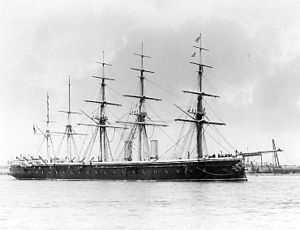Channel Fleet
| Channel Fleet | |
|---|---|
 British ironclad HMS Minotaur as Channel Fleet flagship, after 1875. | |
| Active | 1690-1909 |
| Country |
|
| Branch |
|
| Type | Fleet |
| Garrison/HQ | Torbay, Falmouth and Plymouth. |
The Channel Fleet was the Royal Navy formation of warships that defended the waters of the English Channel from 1690 to 1909.
History
The Channel Fleet dates back at least to 1690 when its role was to defend England against the French threat under the leadership of Edward Russell, 1st Earl of Orford who was then the Commander-in-Chief, Channel Fleet.[1] By 1801 its main role was still to stop French ships from the French naval bases at Brest, Le Havre and elsewhere in the Bay of Biscay from entering the English Channel.[2]
During the 19th century, as the French developed Cherbourg as a base for steam-powered ships, the Royal Navy developed Portland Harbour as a base for the fleet.[3] The harbour was built between 1849 and 1872 when the Royal Navy created a breakwater made of blocks from local quarries on the Isle of Portland.[4] The Channel Squadron only became a permanent formation in 1858.[5]
With the amelioration of Anglo-French relations, and the rise of German militarism towards 1900, the need for the Channel Fleet diminished and the main European naval arena shifted to the North Sea.
Admiral Sir Arthur Wilson was officially "Senior Officer in Command of the Channel Squadron" from 1901 to 1903. His subordinate flag officer in that squadron was the Second-in-Command, who commanded a division of battleships. On 14 December 1904 the Channel Fleet was re-styled the 'Atlantic Fleet' and the Home Fleet became the 'Channel Fleet'.[6]
On 24 March 1909, under a fleet re-organisation, the Channel Fleet became the 2nd Division of the Home Fleet.[7]
Channel Fleet in literature
The Channel Fleet features in several historical novels about the Royal Navy, notably Hornblower and the Hotspur by C. S. Forester, in which Forester's fictional hero becomes a favourite of the real Channel Fleet commander, Admiral William Cornwallis. The fleet also features in several of the Aubrey-Maturin novels by Patrick O'Brian.
The novel Billy Budd by Herman Melville is set on board ships of the Channel Fleet, in the immediate aftermath of the Spithead and Nore mutinies of 1797.
In the novel The War of the Worlds, the Channel Fleet protects the huge mass of refugee shipping escaping from the Essex coast in the face of the Martian onslaught. The initial heroic fight of the HMS Thunder Child and the subsequent general engagement, is detailed in the chapter entitled "The Thunderchild".
Commanding officers
Commanders-in-Chief have included:[8][9]
- Vice Admiral Lord Anson (1746–1747)
- Vice Admiral Augustus Keppel (1778–1779)
- Vice Admiral Charles Hardy (1779–1780)
- Vice Admiral Sir Francis Geary (May 1780-September 1780)
- Vice Admiral George Darby (1780–1782)
- Vice Admiral Earl Howe (1782–1783)
- Vice Admiral Earl Howe (1793–1795)
- Vice Admiral Lord Bridport (1795–1800)
- Vice Admiral Lord St Vincent (1800–1803)
- Vice Admiral Sir William Cornwallis (1803–1806)
- Vice Admiral Lord St Vincent (1806–1807)
- Vice Admiral Lord Gardner (1807–1808)
- Vice Admiral Lord Gambier (1808–1811)
- Vice Admiral Sir Charles Cotton (1811–1812)
- Vice Admiral Lord Keith (1812–1814)
- Vice Admiral Sir Edward Codrington (1831)
(experimental cruise)
- Rear Admiral Sir William Parker (1846–1847)
- Rear Admiral Sir Charles Napier (1847–1849)
- Commodore Sir William Martin (1849–1852)
- Rear Admiral Armar Corry (1853–1854)
- Vice Admiral Sir Charles Fremantle (1858–1860)
- Vice Admiral Sir Robert Stopford (1860–1861)
- Vice Admiral Sir Robert Smart (1861–1863)
- Vice Admiral Sir Sydney Dacres (1863–1866)
- Vice Admiral Sir Hastings Yelverton (1866–1867)
- Vice Admiral Frederick Warden (1867–1868)
- Vice Admiral Sir Thomas Symonds (1868–1870)
- Vice Admiral Sir Hastings Yelverton (July 1870-October 1870)
- Vice Admiral Sir George Wellesley (1870–1871)
- Vice Admiral Sir Geoffrey Hornby (1871–1874)
- Vice Admiral Sir Beauchamp Seymour (1874–1877)
- Vice Admiral Lord John Hay (1877–1879)
- Vice Admiral Lord Hood (1880–1882)
- Vice Admiral Sir William Dowell (1882–1883)
- Vice Admiral The Duke of Edinburgh (1883–1884)
- Vice Admiral Sir Algernon de Horsey (1884–1885)
- Vice Admiral Charles Fellowes (1885–1886)
- Vice Admiral Sir William Hewett (1886–1888)
- Vice Admiral Sir John Baird (1888–1890)
- Vice Admiral Sir Michael Culme-Seymour (1890–1892)
- Vice Admiral Sir Henry Fairfax (1892–1894)
- Vice Admiral Sir Robert Fitzroy (1894–1895)
- Vice Admiral Lord Walter Kerr (1895–1897)
- Vice Admiral Sir Henry Stephenson (1897–1898)
- Vice Admiral Sir Harry Rawson (1898–1901)
- Vice Admiral Sir Arthur Wilson (1901–1903)
- Vice Admiral Lord Charles Beresford (1903–1905)
- Vice Admiral Sir Arthur Wilson (1905–1907)
- Vice Admiral Lord Charles Beresford (1907–1909)
- Vice Admiral Sir Lewis Bayly (1914-1915)
References
- ↑ "Admiral Edward Russell, 1st Earl of Orford". The Peerage. 26 May 2012.
- ↑ Channel Fleet in 1801 at the Nelson Society
- ↑ Channel Fleet The Heritage Coast
- ↑ Portland Harbour Authority: History
- ↑ William Loney RN: Channel Fleet
- ↑ National Archives records
- ↑ HMS Bulwark
- ↑ William Loney RN
- ↑ Whitaker's Almanacks 1900 - 1909